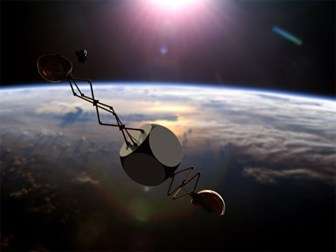Project aims to remove space debris

(Phys.org) -- Low Earth Orbit is overcluttered with rogue objects and collision shrapnel that are a constant threat to spacecraft.
Experts say that a traditional satellite mission to go capture each object is not efficient enough to make an appreciable difference due to the high cost of orbit transfers. Many alternate proposals are politically controversial, costly or dependent on further technological advances; therefore, they are not adequate solutions at present, and none have been proven feasible.
Dr. Daniele Mortari, professor in the Department of Aerospace Engineering, and his Ph.D. student Jonathan Missel are developing a new and creative mission structure that reinvents the way the problem is approached.
Traditional missions plan to rendezvous with each object, capture them softly, and then transfer to the next object. In terms of fuel consumption, these maneuvers are hugely expensive. The proposed mission, "TAMU Sweeper," and the novel satellite design, "Sling-Sat," reclaim the fuel losses of a traditional mission by capturing and then ejecting each object throughplastic collisions.
Welcoming collisions strongly reduce (or even eliminate) the need to burn fuel for rendezvous, and ejecting the debris mass keeps the craft light. In addition, the momentum exchanged in the capture and ejection of each object can be intelligently planned to act as a free impulses for the satellite to transfer to the next object, in place of fuel. The free impulses from capture and ejection are both considered in trajectory optimization to maximize their effectiveness.
The proposed satellite design, Sling-Sat, also exploits existing momentum to save fuel. Debris is captured at the ends of a spinning satellite. Adjustable arms control the angular rate to achieve a desired tangential ejection speed. Timing the release exacts the ejection angle. Through this process, debris can be redirected to burn up in the atmosphere or, by lowering the perigee; the consequent drag increase will then reduce the debris lifetime. Detailed design studies that aim to establish a feasible hardware realization will be conducted over the coming year.
Provided by Texas A&M University













.jpg)




